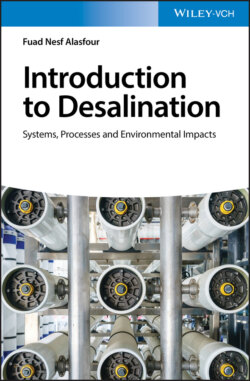Читать книгу Introduction to Desalination - Fuad Nesf Alasfour - Страница 11
1 Introduction 1.1 What Is Desalination?
ОглавлениеDesalination is a process of separating and removing unwanted dissolved salts and minerals from feedwater sources such as seawater, brackish water, or wastewater.
The aim of desalination process is to produce a stream of fresh water (potable) with high quality (purity) according to the standards of World Health Organization (WHO), which state that the accepted maximum limit of total dissolved salts (TDS) in fresh water is 500 ppm (500 mg/l); if we take seawater (called feed or saline) as an example with a salinity of 35 000 ppm, feed can be desalted through two main industrial processes: (i) thermal desalination technologies where feed phase changes through evaporation and condensation processes and (ii) membrane desalination technologies where separation of salts achieved through using semipermeable membrane without feed phase change. In either process, potable water is produced, and salty water (called brine or concentrate) is rejected from desalination system; the rejected brine salinity varies in concentration based on technology, and it can reach up to 90 000 ppm.
Today, desalination industry plays a vital role in society development and economic growth, and worldwide freshwater consumption rate is approximately doubled every 20 years, where the availability of natural water sources is depleted. According to UN report and in the light of global population growth, statistics showed that one‐third of world's population lives under a state of insufficient potable water resources and in communities that suffer from scarcity and water stress. As prehuman body, water is essentially needed for building tissues, blood circulation, and maintaining stable blood temperature, and based on human weight it is recommended that a human drinks 8–14 glasses of water every day. Today desalination industries tend to provide safe drinking water to achieve and maintain sustainable human life and minimize negative environmental impacts. As per industry, there are eight major water‐consuming industrial sectors: power generation, food, pharmaceutical, mining, oil, petrochemical, electronics, and paper.
There are several types of “well‐proven” industrial desalination technologies that have been used in the last seven decades. Note that the major parameters that affect desalination technology performance are feed type and its thermal‐physical characteristics, in addition to the required desalted water quality (purity).
Figure 1.1 shows the classification of desalination systems based on separation processes. Note that such processes can be operated by conventional energy type such as fossil fuel (thermal and electrical) or by renewable energy types such as solar, wind, and geothermal (Chapter 9).
Statistics by IDA for year 2015 shows that there are 18 426 desalination plants worldwide, producing 86.8 × 106 m3/d and serving more than 300 × 106 in 150 countries per day, and such production can provide potable water for municipal, industrial, and agriculture sectors. Today Gulf countries produce around 57% of world desalination capacity [2].
Figure 1.1 Desalination processes based on separation type.
